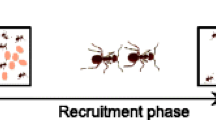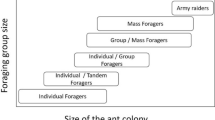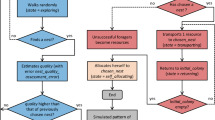Abstract
Many decisions involve a trade-off between commitment and flexibility. We show here that the collective decisions ants make over new nest sites are sometimes sufficiently flexible that the ants can change targets even after an emigration has begun. Our findings suggest that, in this context, the ants’ procedures are such that they can sometimes avoid ‘negative information cascades’ which might lock them into a poor choice. The ants are more responsive to belated good news of a higher quality nest than they are when the nest they had initially chosen degraded to become worse than an alternative. Our study confirms, in a new way, that ant colonies can be very powerful “search engines”.
Similar content being viewed by others

Explore related subjects
Discover the latest articles, news and stories from top researchers in related subjects.References
Beckers, R., Deneubourg, J. L., Goss, S., & Pasteels, J. M. (1990). Collective decision making through food recruitment. Insectes Sociaux, 37, 258–267.
Beckers, R., Deneubourg, J. L., & Goss, S. (1992). Trail laying behavior during food recruitment in the ant Lasius niger (L.). Insectes Sociaux, 39, 59–72.
Benjamini, Y., & Yekutieli, D. (2001). The control of the false discovery rate in multiple testing under dependency. Annals of Statistics, 29, 1165–1188.
Berman, S., Halász, Á., Kumar, V., & Pratt, S. (2006). Algorithms for the analysis and synthesis of a bio-inspired swarm robotic system. In Lecture notes in computer science : Vol. 4433. Proceedings of the 2nd SAB 2006 international workshop on swarm robotics (pp. 56–70). Berlin: Springer.
Berman, S., Halász, Á., Kumar, V., & Pratt, S. (2007). Bio-inspired group behaviors for the deployment of a swarm of robots to multiple destinations. In Proceedings of the 2007 IEEE international conference on robotics and automation (pp. 2318–2323). Los Alamitos: IEEE Computer Society Press.
Bonabeau, E., Dorigo, M., & Theraulaz, G. (1999). Swarm intelligence: from natural to artificial systems (p. XII+307). New York: Oxford University Press.
Bourke, A. F. G., & Franks, N. R. (1995). Social evolution in ants. Monographs in behavioral ecology (p. XIV+529). Princeton: Princeton University Press.
Britton, N. F., Franks, N. R., Pratt, S. C., & Seeley, T. D. (2002). Deciding on a new home: how do honeybees agree? Proceedings of the Royal Society of London Series B, 269, 1383–1388. doi:10.1098/rspb.2002.2001.
Camazine, S., Deneubourg, J.-L., Franks, N. R., Sneyd, J., Theraulaz, G., & Bonabeau, E. (2001). Self-organization in biological systems. Princeton: Princeton University Press.
Chittka, L., Dyer, A. G., Bock, F., & Dornhaus, A. (2003). Bees trade off foraging speed for accuracy. Nature, 424, 388.
Cicirello, V., Peysakhov, M., Anderson, G., Naik, G., Tsang, K., Regli, W., & Kam, M. (2005). Designing dependable agent systems for mobile wireless networks. IEEE Intelligent Systems, 19, 39–45. doi:10.1109/MIS.2004.41.
Conradt, L., & Roper, T. J. (2005). Consensus decision making in animals. Trends in Ecology and Evolution, 20, 449–456. doi:10.1016/j.tree.2005.05.008.
Couzin, I. D., Krause, J., Franks, N. R., & Levin, S. A. (2005). Effective leadership and decision-making in animal groups on the move. Nature, 433, 513–516. doi:10.1038/nature03236.
Dean, T. L., & Boddy, M. (1988). An analysis of time-dependent planning. In T. M. Mitchell & G. Smith (Eds.), Proceedings of the seventh national conference on artificial intelligence (pp. 49–54). Menlo Park: AAAI Press.
Dechaume-Moncharmont, F.-X., Dornhaus, A., Houston, A. I., McNamara, J. M., Collins, E. J., & Franks, N. R. (2005). The hidden cost of information in collective foraging. Proceedings of the Royal Society B, 272, 1689–1695. doi:10.1098/rspb.2005.3137.
Dornhaus, A., Franks, N. R., Hawkins, R. M., & Shere, H. N. S. (2004). Ants move to improve—colonies of Leptothorax albipennis emigrate whenever they find a superior nest site. Animal Behaviour, 67, 959–963.
Dornhaus, A., & Franks, N. R. (2006). Colony size affects collective decision-making in the ant Temnothorax albipennis. Insectes Sociaux, 53, 420–427. doi:10.1007/s0040-006-0887-4.
Dornhaus, A., Collins, E. J., Dechaume-Moncharmont, F.-X., Houston, A. I., Franks, N. R., & McNamara, J. M. (2006). Paying for information: partial loads in central place foragers. Behavioral Ecology and Sociobiology, 61, 151–161. doi:10.1007/s00265-006-0246-5.
Franks, N. R. (1989). Army ants: a collective intelligence. American Scientist, 77, 138–145.
Franks, N. R., & Richardson, T. (2006). Teaching in tandem-running ants. Nature, 439, 153. doi:10.1038/439153a.
Franks, N. R., Pratt, S. C., Mallon, E. B., Britton, N. F., & Sumpter, D. J. T. (2002). Information flow, opinion-polling and collective intelligence in house-hunting social insects. Philosophical Transactions of the Royal Society of London Series B, 357, 1567–1583.
Franks, N. R., Dornhaus, A., Fitzsimmons, J. P., & Stevens, M. (2003a). Speed versus accuracy in collective decision-making. Proceedings of the Royal Society of London Series B, 270, 2457–2463. doi:10.1098/rspb.2003.2527.
Franks, N. R., Mallon, E. B., Bray, H. E., Hamilton, M. J., & Mischler, T. C. (2003b). Strategies for choosing among alternatives with different attributes: exemplified by house-hunting ants. Animal Behaviour, 65, 215–223. doi:10.1006/anbe.2002.2032.
Franks, N. R., Dornhaus, A., Best, C. S., & Jones, E. L. (2006a). Decision-making by small & large house hunting ant colonies: one size fits all. Animal Behaviour, 72, 611–616. doi:10.1016/j.anbehav.2005.11.019.
Franks, N. R., Dornhaus, A., Metherell, B. G., Nelson, T. R., Lanfear, S. A. J., & Symes, W. S. (2006b). Not everything that counts can be counted: Ants use multiple metrics for a single nest trait. Proceedings of the Royal Society of London Series B, 273, 165–169. doi:10.1098/rspb.2005.3312.
Franks, N. R., Hooper, J. W., Dornhaus, A., Aukett, P. J., Hayward, A. L., & Berghoff, S. M. (2007). Reconnaissance and latent learning in ants. Proceedings of the Royal Society of London Series B, 274, 1505–1509. doi:10.1098/rspb.2007.0138.
Giraldeau, L.-A., Valone, T. J., & Templeton, J. J. (2002). Potential disadvantages of using socially acquired information. Philosophical Transactions of the Royal Society of London Series B, 357, 1559–1566. doi:10.1098/rstb.2002.1065.
Janson, S., Middendorf, M., & Beekman, M. (2007). Searching for a new home—scouting behavior of honeybee swarms. Behavioral Ecology, 18, 384–392. doi:10.1093/beheco/arl095.
King, A. J., & Cowlishaw, G. (2007). When to use social information: the advantage of large group size in individual decision making. Biology Letters, 3, 137–139. doi:10.1098/rsbl.2007.0017.
Mallon, E. B., Pratt, S. C., & Franks, N. R. (2001). Individual and collective decision-making during nest site selection by the ant Leptothorax albipennis. Behavioral Ecology and Sociobiology, 50, 352–359. doi:10.1007/s002650100377.
Marshall, J. A. R., Dornhaus, A., Franks, N. R., & Kovacs, T. (2006). Noise, cost and speed-accuracy trade-offs: decision-making in a decentralized system. Journal of the Royal Society: Interface, 3, 243–254. doi:10.1098/rsif.2005.0075.
Pearson, B., Raybould, A. F., & Clarke, R. T. (1995). Breeding behavior, relatedness and sex- investment ratios in Leptothorax tuberum Fabricius. Entomologia Experimentalis et Applicata, 75, 165–174.
Peysakhov, M. D., & Regli, W. C. (2005). Ant inspired server population management in a service based computing environment. In Proceedings of the 2005 IEEE swarm intelligence symposium (pp. 357–364). Los Alamitos: IEEE Computer Society Press. doi:10.1109/SIS. 2005.1501643.
Peysakhov, M., Dugan, C., Modi, P. J., & Regli, W. (2006). Quorum sensing on mobile ad-hoc networks. In Proceedings of the 5th international joint conference on autonomous agents and multiagent systems (pp. 1104–1106). New York: ACM. doi:10.1145/1160633.1160831.
Planqué, R., Dornhaus, A., Franks, N. R., Kovacs, T., & Marshall, J. A. R. (2006). Weighting waiting in collective decision-making. Behavioral Ecology and Sociobiology, 61, 347–356. doi:10.1007/s00265-006-0263-4.
Pratt, S. C., & Sumpter, D. J. T. (2006). A tunable algorithm for collective decision-making. Proceedings of the National Academy of Sciences of the United States of America, 103, 15906–15910. doi:10.1073/pnas.0604801103.
Pratt, S. C., Mallon, E. B., Sumpter, D. J. T., & Franks, N. R. (2002). Quorum sensing, recruitment, and collective decision-making during colony emigration by the ant Leptothorax albipennis. Behavioral Ecology and Sociobiology, 52, 117–127. doi:10.1007/s00265-002-0487-x.
Pratt, S. C., Sumpter, D. J. T., Mallon, E. B., & Franks, N. R. (2005). An agent-based model of collective nest choice by the ant Temnothorax albipennis. Animal Behaviour, 70, 1023–1036. doi:10.1016/j.anbehav.2005.01.022.
Seeley, T. D. (1995). The wisdom of the hive. Cambridge: Harvard University Press.
Seeley, T. D., & Buhrman, S. (1999). Group decision making in swarms of honey bees. Behavioral Ecology and Sociobiology, 45, 19–31. doi:10.1007/s002650050536.
Visscher, P. K. (2007). Group decision making in nest-site selection among social insects. Annual Review of Entomology, 52, 255–275. doi:10.1146/annurev.ento.51.110104.151025.
Author information
Authors and Affiliations
Corresponding author
Rights and permissions
About this article
Cite this article
Franks, N.R., Hooper, J.W., Gumn, M. et al. Moving targets: collective decisions and flexible choices in house-hunting ants. Swarm Intell 1, 81–94 (2007). https://doi.org/10.1007/s11721-007-0007-8
Received:
Accepted:
Published:
Issue Date:
DOI: https://doi.org/10.1007/s11721-007-0007-8



